/Vehicles/Axis/Germany/02-mPanzers/PzKpfw4/File/7-inAction.htm | Last Up-date:
Panzerkampfwagen IV Medium Tank
in Action
La fonction primaire du PzKpfw IV était de procurer support rapproché au autres chars de combat des Panzerregiments en détruisant les positions retranchées et les armes anti-chars ennemies susceptibles de retarder ou de stopper l'avance. Dans ce but dans les Pz.Abteilungen, la 4e compagnie (lourde) était composée de Panzer s IV. Cependant dans la pratique chaque compagnie disposait de quelques Panzer IV pour une disponibilité immédiate. Lors des assauts, les Pz.Kpfw 38(t)s et Pz.Kpfw III formaient l'avant-garde alors que les chars légers Pz.Kpfw I et Pz.Kpfw II occupaient les flancs. Les Pz.Kpfw IVs formaient quant à eux l'arrière-garde, choisissant leurs cibles à distance et tiraient leurs coups (canon de 75 mm L/24 à faible vélocité) par dessus les premières lignes. Les tâches de combat secondaires étaient généralement confiées aux régiments d'infanterie motorisée plus connus après 1942 en tant que Panzergrenadiers. Les action des Panzerdivisions, ne nécessitant pas toujours le plein emploi de leurs effectifs de chars, une compagnie lourde complète, était attachée provisoirement à ces régiments d'infanterie motorisée. Celaleur offrait un appui feu particulièrement apprécié. Cependant, la Panzerwaffe était en générale contre cet usage considérant celacomme une dispersion de précieuses ressources dans un rôle pour lesquels la Sturmartillerie avait été spécifiquement conçue.
The primary function of PzKpfw IV was to provide close fire support to the other tanks of Panzerregiments by destroying the cut off positions and the enemy anti-tank weapons likely to delay or stop the advance. To this end in Pz.Abteilungen, the 4th company (heavy) was made up of Panzers IV. However in practice each company had some Panzer IV for an immediate availability. At the time of the attacks, Pz.Kpfw 38(t)s and Pz.Kpfw III formed the spearhead whereas the light tanks Pz.Kpfw I and Pz.Kpfw II occupied the sides. Pz.Kpfw IV formed as for them the rear-guard, choosing their targets at long range and drew their rounds (gun of 75 mm L/24 with low initial speed) over the first lines. The secondary tasks of combat were generally entrusted to the regiments of infantry motorized more known after 1942 as Panzergrenadiers. The action of Panzerdivisions, not requiring always the full employment of their strength of tanks, a complete heavy company, was attached temporarily to these regiments of motorized infantry. That offered a support of fire particularly appreciated. However, Panzerwaffe was in general against this use considering that as a dispersion of invaluable resources in a role for which Sturmartillerie had been specifically conceived.
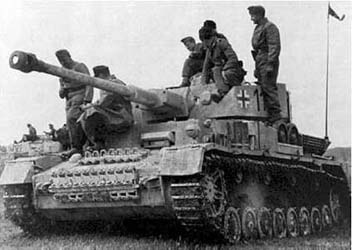 |
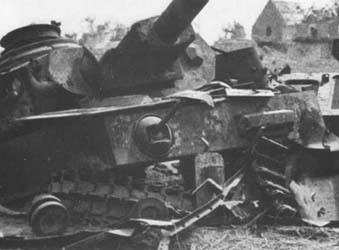 |
Pz.Kpfw IV Ausf.G. |
Pz.Kpfw IV Ausf.H complètement détruit dans les champs de Vaucelles (France), le 18 juillet 1944. |
Pz.Kpfw IV Ausf.H completely
destroyed in the fields of Vaucelles (France), July 18 1944. |
|
src:
Site www.wwiivehicles.com |
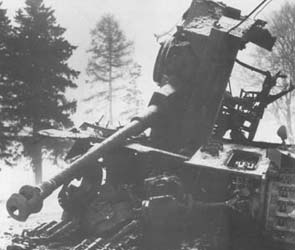 |
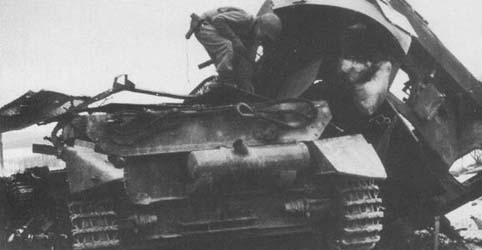 |
Panzer IV Ausf.H détruit lors de l'acharnée
défense de Bastogne en décembre 1944. |
Pz.Kpfw IV Ausf.J détruit par un M10
américain durant le retrait américain de Wirtzfeld
le 17 décembre 1944. |
Panzer IV Ausf.H destroys
at the time of the furious defense of Bastogne in December 1944.
|
Pz.Kpfw IV Ausf.J destroys
by a M10 American during the American withdrawal of Wirtzfeld
December 17 1944. |
|
|
src: Tank Illustrated n°2 |
Pendant les campagnes de 1939 et de 1940 les Panzerdivisons incluaient deux régiments blindés de deux bataillons (Panzer Abteilung), chaque bataillon se composait de quatre compagnies. Ça c'est pour la théorie, en pratique, septembre 1939 une Panzerdivision moyenne ne possédait pas plus de 24 Pz.Kpfw IVs, ou deux à trois chars par section. Résultat, le plus souvent, le personnel d'une compagnie par bataillon restait en chômage technique à l'arrière dans les dépôts. En mai 1940 la moyenne grimpa à 36 PzKpfw IVs par division (seulement dans les certaines divisions privilégiées), ou trois pelotons de trois chars par bataillon. D'autres se contentaient toujours de 24 Panzers IV.
During the campaigns of 1939 and 1940 Panzerdivisons included two armoured regiments of two battalions (Panzer Abteilung), each battalion was composed of four companies. That it is for the theory, in practice, September 1939 standard Panzerdivision did not have more than 24 Pz.Kpfw IV, or two to three tanks per section. Result, generally, the personnel of a company per battalion remained in layoff to the back in the deposits. In May 1940 the average climbed to 36 PzKpfw IV by division (only in certain privileged divisions), or three groups of three tanks per battalion. Others were always satisfied with 24 Panzers IV.
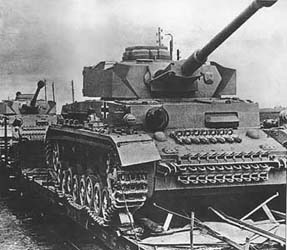 |
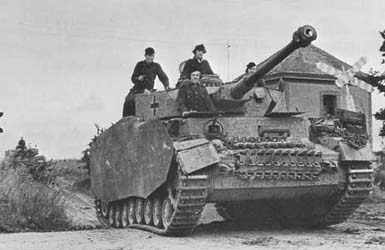 |
Pz.Kpfw IV Ausf.H sur convoy ferroviaire |
Pz.Kpfw IV Ausf.H de la 21e Panzerdivision
à l'est de Caen un peu avant l'opération Godwood,
fin juin 1944 en Normandie. |
Pz.Kpfw IV Ausf.H on
rail convoy |
Pz.Kpfw IV Ausf.H of
the 21st Panzerdivision to the east of Caen a little before the
operation Godwood, late June 1944 in Normandy. |
src:
Site www.wwiivehicles.com |
src: Normandie 44, Album
Mémorial, Ed.Heimdal |
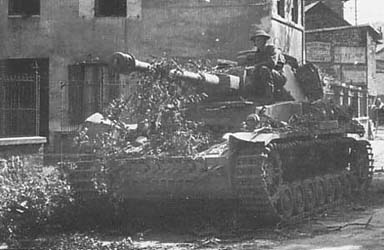 |
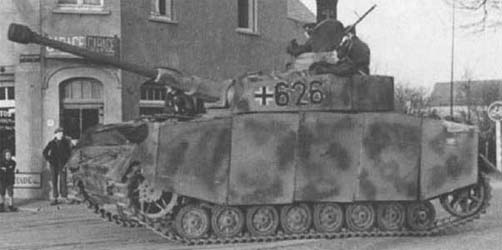 |
Pz.Kpfw IV Ausf.H abandonné à
Elboeuf et découvert par les Canadiens de la 2e DI. |
Panzer IV Ausf.H de la 12e SS-Hitlerjugen-Panzerdivision.
Seules les unités d'élites étaient correctement
équippées en Panzers IV. |
Pz.Kpfw IV Ausf.H abandoned
to Elboeuf and discovered by the Canadians of the 2nd ID. |
Panzer IV Ausf.H of
12th SS-Hitlerjugen-Panzerdivision. Only the units of elites were
correctly equipped in Panzers IV. |
src: Normandie 44, Album
Mémorial, Ed.Heimdal |
src: Site "Juggernauts
of the second world war" |
| Tank
strenghts of Panzerdivisions |
|
| 1939/1940 |
324 |
| 1941/1942 |
150-200 |
| 1943 |
170 |
| 1944 |
120-140 |
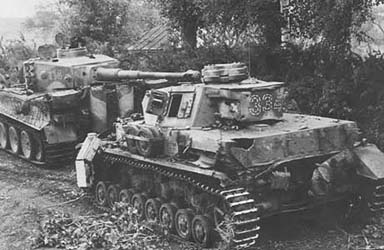 |
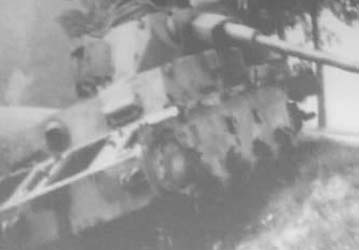 |
Pz.Kpfw IV Ausf.H récupéré
par un Tigre sur le front est |
Autre Pz.Kpfw IV Ausf.H abandonnés
durant l'offensive des Ardennes. |
Pz.Kpfw IV Ausf.H recovered
by a Tiger on the Eastern front |
Other Pz.Kpfw IV Ausf.H
abandoned during the offensive of the Ardennes. |
src: Site www.wwiivehicles.com |
src: Jean-Michel Delvaux
|
Après la victoire en France, Hitler décida de doubler le nombre de Panzerdivisions. Ceci fut réalisé en ne pourvoyant plus les Panzerdivisons que d'un seul régiment avec 4 bataillons ou encore deux régiments de deux bataillons. Cependant six régiments seront dotés de trois bataillons. Lors de "Barbarossa" en juin 1941, 17 Panzerdivisions équipées d'un total de 3.200 chars dont 517 Pz.Kpfw IVs étaient disponibles. Chaque Panzerdivision était en moyenne équipée de 30 Panzers IV, ou 3-5 sections par bataillon de chars. Le Panzer IV à cette époque ne représentait qu'un sixième des effectifs de chars. L'apparition du T-34 du KV-1 avec leur blindage épais jeta la stupéfaction et le désarroi au sein des Panzerdivisions. Une réorganisation interne des bataillons de Panzer était urgentes. Les Pz.Kpfw I et II complètement obsolètes disparurent, et les bataillons furent désormais composés des seuls Pz.Kpfw III à canons de 50 mm L/42 ou L/60 et de Pz.Kpfw IV à canon de 75 mm L/24. Cependant, le 75 mm L/24 n'était pas au départ conçu pour le combat char vs char et il commença à être remplacé par les 75 mm L/43 et L/48. Le Pz.Kpfw IV étant devenu un char de bataille à part entière, le concept de compagnie lourde était donc devenu désuet, et les bataillons furent désormais dotés de seulement trois compagnies pareillement équipées.
After the victory in France, Hitler decided to double the number of Panzerdivisions. This was carried out by not providing more Panzerdivisons of only one regiment with 4 battalions or two regiments with two battalions. However six regiments will be equipped with three battalions. At the time of "Barbarossa" in June 1941, 17 Panzerdivisions equipped with a total of 3.200 tanks which 517 Pz.Kpfw IV were available. Each Panzerdivision was on average equipped with 30 Panzers IV, or 3-5 sections by battalion of tanks. Panzer IV at that time represented only one sixth of strength of tanks. The appearance of T-34 of Kv-1 with their thick shielding threw amazement and the distress within Panzerdivisions. An internal reorganization of the battalions of Panzer was urgent. Obsolete Pz.Kpfw I and II completion disappeared, and the battalions from now on were composed of only Pz.Kpfw III with guns of 50 mm L/42 or L/60 and of Pz.Kpfw IV with gun of 75 mm L/24. Cependant, the 75 mm L/24 was not with the departure conceived for the combat tank vs tank and it started to be replaced by the 75 mm L/43 and L/48. Pz.Kpfw IV having become a tank of battle to whole share, the concept of heavy company had thus become obsolete, and the battalions from now on were equipped with only three companies identically equipped.
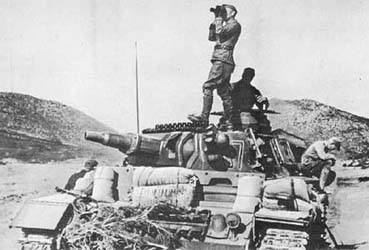 |
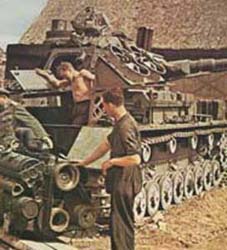 |
Le Panzer IV (75 mm L/24)
était au départ un char de support fournissant un
appui feu au Panzers III. |
Vue intéressante de la maintenance
générale d'un Panzer IV |
Panzer IV (75 mm L/24)
was at the beginning a tank of support providing a fire support
to Panzers III. |
Interesting view of
the general maintenance of Panzer IV |
src: Site "Juggernauts
of the second world war" |
src:
Site Panzer
Page von Reitsch |
 |
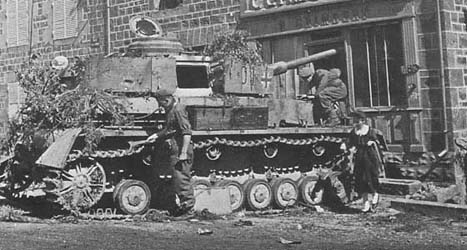 |
Panzer IV Ausf.G de la 16e Panzer durant la
campagne d'Italie en 1943. |
Panzer IV ayant pénétré
un peu brutalement dans une cordonnerie à Putanges dans
la poche de Falaise en août 1944. |
Panzer IV Ausf.G of 16th Panzer during
the campaign of Italy in 1943. |
Panzer IV having penetrated
a little brutally in a shoe repair to Putanges in the Falaise
pocket in August 1944. |
src: Normandie 44, Album
Mémorial, Ed.Heimdal |
Tout au long de la guerre la production de char demeura lente (en raison de la complexité et du coup élevé des conceptions allemandes), et résultat il n'y eut jamais assez de Pz.Kpfw IV pour que tous les bataillons soient dotés uniquement de ce char. De plus en 1942, Hitler ordonna un accroissement du nombre de Panzerdivisions malgré les pertes lourdes de matériel subies l'année précédente. Sur le front oriental, dans les secteurs nord et central, la situation relativement calme, permis de réduire les régiments à un bataillon simple. Par contre dans la zone sud où les combats étaient plus violents, un régiment comprenait trois bataillons, ce qui ne représentait que seulement 170 chars (320 par régiments en Pologne en 1939). Les compagnies des bataillons furent poussées à quatre, mais dans la majorité des cas le matériel n'était pas disponible ! En effet, après Stalingrad et la retraite du Caucase, une division (secteur sud) comprenait en moyenne seulement 27 chars ! Le 1er mars 1943 Guderian ramené au service actif fut nommé inspecteur général et Albert Speer fut nommé ministre de la production. Le résultat fut que le nombre de Pz.Kpfw IVs produits commença à monter brusquement. Le nouveau char de bataille, le Pz.KpFw V Panther, fit également son apparition en 1943, mais il ne se substituera jamais au Pz.KpFw IV, bien qu'il ait été prévu pour çà.
Throughout the war the production of tank remained slow (because of the complexity and the high cost of the German designs), and result it never had enough Pz.Kpfw IV there so that all the battalions are equipped only with this tank. Moreover in 1942, Hitler ordered an increase in the number of Panzerdivisions in spite of the heavy looses of material during the previous year. On the Eastern front, in the sectors north and centre, the relatively calm situation, allowed to reduce the regiments to a simple battalion. On the other hand in the southern zone where the engagements were more violent one, a regiment included three battalions, which represented only only 170 tanks (320 by regiments in Poland in 1939). The companies of the battalions were pushed to four, but in the majority of the cases the material was not available! Indeed, after Stalingrad and the retirement of the Caucasus, a division (southern sector) on average included only 27 tanks! March 1, 1943 Guderian brought back to the active service was named general inspector and Albert Speer was named Minister for the production. The result was that the number of Pz.Kpfw IV produced started to go up abruptly. The new tank of battle, Pz.KpFw V Panther, also made its appearance in 1943, but it will never replace Pz.KpFw IV, although it was planned for that.
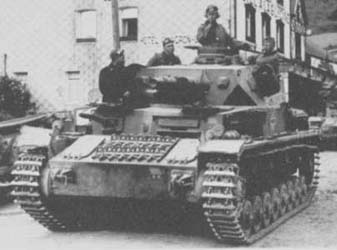 |
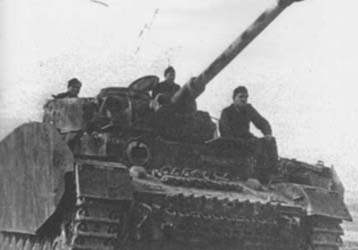 |
Pz.Kpfw IV Ausf.D de la 5e compagnie de la
2e Panzerdivision sur la Semois le 12 mai 1940. |
Pz.Kpfw IV Ausf.H du 8./SS-Pz.Rgt 3 dans les
plaines de Picardie au début de 1944. |
Pz.Kpfw IV Ausf.D from
5th company of 2nd Panzer Division in Semois on May 12th of 1940. |
Pz.Kpfw IV Ausf.H of
the 8./SS-Pz.Rgt 3 in the plains of Picardie at first of 1944.
|
src:
Site Lexikon
der Wehrmacht |
src: Les Panzers (Normandie
44), Ed. Heimdal |
| Tanks
available in Panzertruppe |
|||
| Date: | Quantity: | Date: | Quantity: |
| 06/1941 | 5639 | 06/1944 | 9148 |
| 03/1942 | 5087 | 09/1944 | 10563 |
| 05/1942 | 5847 | 10/1944 | 11005 |
| 11/1942 | 7798 | 11/1944 | 12236 |
| 03/1943 | 5625 | 12/1944 | 13175 |
| 08/1943 | 7703 | 01/1945 | 13362 |
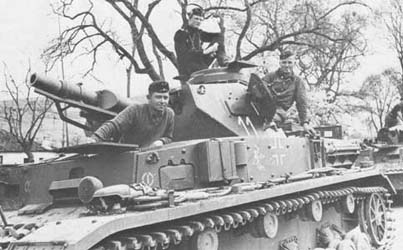 |
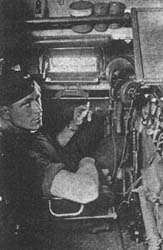 |
Panzer IV Ausf.E de la 11e Panzer durant
la campagne des Balkans au printemps 1941. |
Poste de pilotage d'un Panzer IV |
Panzer IV Ausf.E of
11th Panzer during the campaign of Balkans in spring 1941. |
Driver station of
a Panzer IV |
src: Les Panzers (Normandie
44), Ed. Heimdal |
A partir de la mi 1943, l'Allemagne fut sur la défensive, la Panzerwaffe avait perdu l'initiative et était désormais le plus souvent cantonnée dans un rôle de contre-attaque stratégique. Les régiments d'élite ou les plus chanceux auront un bataillon équipé de Panthers et l'autre de Pz.Kpfw IVs, mais ce n'était pas la norme. En effet, à cause de pertes lourdes non compensées par la production, le matériel manquait et de plus en plus souvent les trous étaient comblés par des canons d'assaut ou chasseurs de char, de sorte qu'en 1944 la plupart des régiments ne comptaient qu'un ou deux compagnies ou un bataillon complet de chars de combat. Les canons d'assaut et les chasseurs de chars avec leur champ de tir horizontal limité, n'étaient pas très efficaces comme char de combat, mais pouvaient assurer un appui feu très appréciable (ce qui notons le, étaient le rôle initial du Pz.Kpfw IV). La situation se dégrada de plus en plus au fil des mois, et les régiments de panzer utilisaient tout ce qui leur tombait sous la main et qui était en état de fonctionner. L'organisation stricte des unités laissa place peu à peu à des groupes de combat ou "Kampfgruppen" composés de tout et n'importe quoi pouvant tirer et rouler.
From mid the 1943, Germany was on the defensive, Panzerwaffe had lost the initiative and from now on was generally confined in a role of strategic counter-attack. The regiments of theelite or luckiest will have a battalion equipped with Panthers and the other of Pz.Kpfw IV, but it was not the standard. Indeed, because of heavy losses not compensated by the production, the material missed and more and more often the holes were filled by assault guns or tank destroyers, so that in 1944 the majority of the regiments counted one or two companies or a complete battalion of tanks. The assault guns and the tank destroyers with their limited horizontal field of fire, were not very effective like battle tank, but could ensure a fire support very appreciable (what note it, were the initial role of Pz.Kpfw IV). The situation was degraded more and more with the wire of month, and the regiments of panzer used all that fell to them under the hand and which was in a position to function. The strict organization of the units left room little by little to groups of combat or "Kampfgruppen" made up of all and anything being able to combat and move.
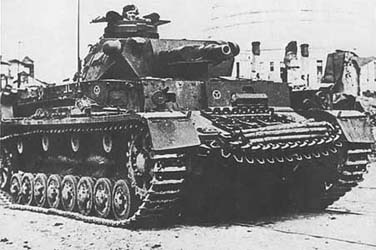 |
 |
Pz.Kpfw IV Ausf.E de la 12e Panzer en Russia, le 9 juillet 1941 |
Panzerkommandant scrutant le ciel. |
Pz.Kpfw IV Ausf.E of
the 12th Panzer Division in Russia on July 9, 1941 |
Panzerkommandant examining
the sky. |
src: Site www.wwiivehicles.com |
src: Les Panzers (Normandie
44), Ed. Heimdal |
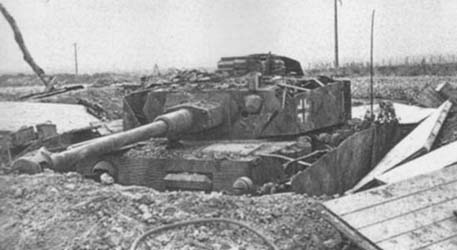 |
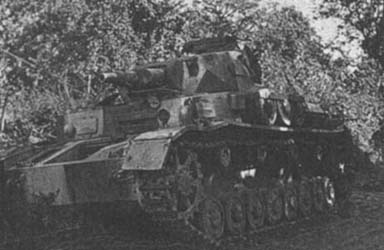 |
Pz.Kpfw IV Ausf.H de la 21e Panzerdivision
enterré pour constitué une ligne défensive
en terrain découvert lors de la bataille de Caen (9-11
juillet 1944). |
Un antique Panzer IV à canon court
(B ou C) du Pz.Rgt.22, Normandie 26 août 1944. |
Pz.Kpfw IV Ausf.H of
the 21st Panzerdivision buried to constitute a defensive line
in open ground at the time of the battle of Caen (9-11 July 1944).
|
An old Panzer IV with
short gun (B or C) of the Pz.Rgt.22, Normandy 26 august 1944.
|
src: Normandie 44, Album
Mémorial, Ed.Heimdal
|
src: Les Panzers (Normandie
44), Ed. Heimdal |
En résumé, conçu à l'origine comme char de support, le Panzer IV devient petit à petit le char de combat par excellence des Panzerdivisions et ne sera jamais remplacé dans ce rôle jusqu'à la fin de la guerre. Les ressources industrielles (de plus en plus limitées) allemandes ne le permirent pas. Robuste, mobile et bien armé il fut un excellent char de combat moyen seulement dépassé par les T-34, KV-I, Sherman(76) et autres chars moyens alliés tardifs. Si au départ, l'armée allemande n'avait pas privilégié la production du Panzer III à son dépend, les Panzerdivisions aurait pu être beaucoup mieux dotés et aptes à réaliser leurs objectifs, mais on ne refait pas la guerre...
In short, conceived at the origin like tank of support, Panzer IV gradually becomes the mainly battle tank of Panzerdivisions and will never be replaced in this role until the end of the war. The industrial German resources (increasingly limited) did not allow it. Robust, mobile and well armed, it was an excellent medium tank only exceeded by T-34, Kv-I, Sherman(76) and other later Allied medium tanks. If at the beginning, the German army had not privileged the production of Panzer III with its depends, Panzerdivisions could have been much better equipped and ready to carry out their objectives, but the war is not remade...
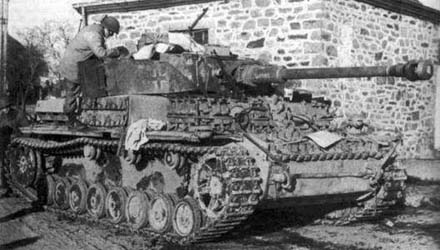 |
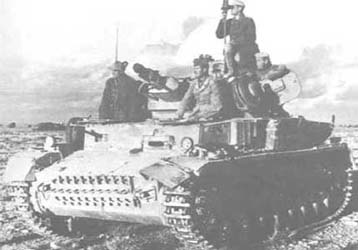 |
Pz.Kpfw IV Ausf.H examiné par un soldat
américain |
Pz.Kpfw IV Ausf.E en Afrique du Nord |
Pz.Kpfw IV Ausf.H examined
by an American soldier |
Pz.Kpfw IV Ausf.E in
North Africa |
src: Site
"Panzerwaffe" |
src: site Photos
Gallery of WW2 |
Le Pz.Kpfw IV sera en service dans les unités blindés de la Wehrmacht et de la Waffen-SS et connu le combat sur tous les fronts: Europe de l'Ouest, Afrique du Nord, Europe de l'Est, Italie, Allemagne.
Pz.Kpfw IV will be in service in the armoured units of Wehrmacht and Waffen-SS and known the combat on all fronts: Western Europe, North Africa, Eastern Europe, Italy, Germany.
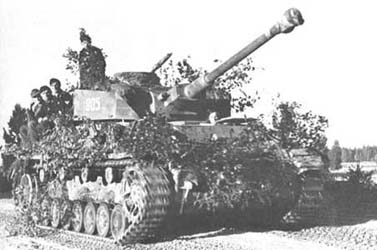 |
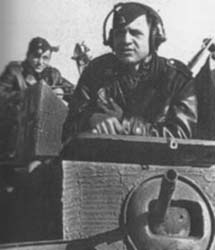 |
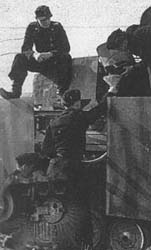 |
Pz.Kpfw IV Ausf.H bien camouflé |
Opérateur-radio-mitrailleur d'un Panzer
IV |
Equipage occupé à faire le plein. |
Pz.Kpfw IV Ausf.H camouflaged
well |
Radio-operateur-machine-gunner
of a Panzer IV |
Crew occupied to fill
up. |
src:
site Photos
Gallery of WW2 |
src: Les Panzers (Normandie 44), Ed. Heimdal |
|
Sources:
- Pz.Kpfw IV in action, Armor Number 12 (squadron/signal publications, inc.)
- Connaissance de l'Histoire (Hachette) - N°17 - " Les chars de combat allemands 39-45"
- Connaissance de l'Histoire (Hachette) - N°5 - " Véhicules blindés allemands 39-45"
- Les Blindés de la Seconde Guerre Mondiale (Atlas)
- Panzerkampfwagen IV Medium Tank 1936-1945 (Osprey Military) - New Vanguard N°28
- Site "Achtung Panzer" - http://www.achtungpanzer.com
- Site "Germany's vehicle history" - http://www.wwiivehicles.com
- Site "Second World War Armour" - http://www.onwar.com/tanks/index.htm